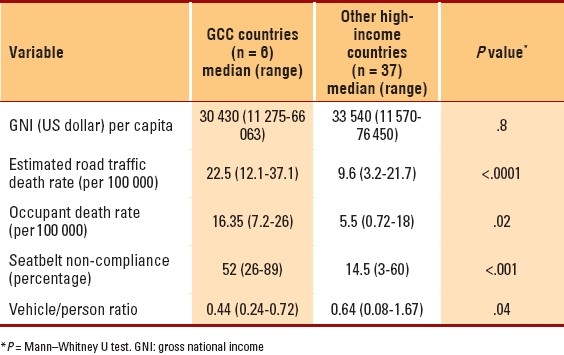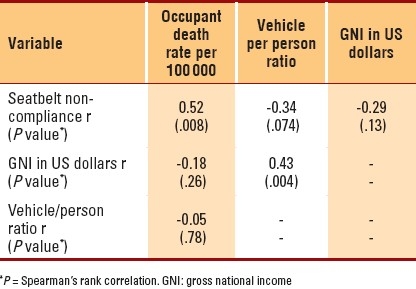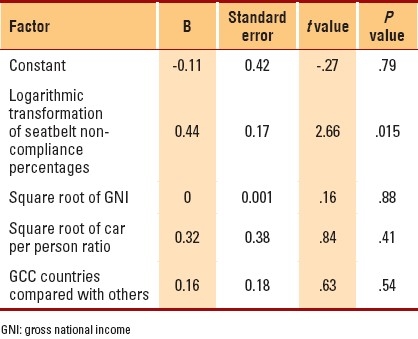Abstract
BACKGROUND AND OBJECTIVES:
Mortality from road traffic collisions (RTC) is a major problem in the Gulf Cooperation Council (GCC) countries. Low compliance with seatbelt usage can be a contributing factor for increased mortality. The present study aimed to ascertain the presence of a relationship between seatbelt non-compliance of vehicle occupants and mortality rates in the GCC countries versus other high-income countries.
DESIGN AND SETTING:
Observational and descriptive study using information published by the World Health Organization
METHODS:
Data for all GCC countries (n=6) and other high-income countries (n=37) were retrieved and compared with regard to population, gross national income, number of vehicles, seatbelt non-compliance and road traffic death rates. Univariate and multivariate analysis were used to define factors affecting the mortality rates.
RESULTS:
The median road traffic death rates, occupant death rates, and the percentage of seatbelt non-compliance were significantly higher in the GCC countries (P<.0001, P=.02, P<.001, respectively). There was a strong correlation between occupant death rates and seatbelt non-compliance (R=.52, P=.008). Seatbelt non-compliance percentage was the only significant factor predicting mortality in the multiple linear regression model (P=.015).
CONCLUSIONS:
Seatbelt non-compliance percentages in the GCC countries are significantly higher than in other high-income countries. This is a contributing factor in the increased road traffic collision mortality rate in these countries. Enforcement of seatbelt usage by law should be mandatory so as to reduce the toll of death of RTC in the GCC countries.
Worldwide, more than 1.2 million people are killed and 50 million are disabled every year because of road traffic collisions (RTCs).1 This global problem has increased in the last two decades. The large increase in the number of vehicles and high speed roads has accounted for this increase in high-income countries,2 including the Gulf Cooperation Council (GCC) countries.3,4 A speed-injury curve shows clearly the strong relationship between high speed and severity of injury.5,6 Energy increases exponentially with an increase in velocity, leading to an increase in serious and fatal collisions. Seatbelts are the most important motor vehicle crash safety innovation that are capable of reducing the morbidity and mortality of RTCs.7,8 Despite this, seatbelts remain underused in many parts of the world as well as in the GCC countries.3,4,9 This study aimed to evaluate the correlation between seatbelt non-compliance of vehicle occupants and vehicle occupant mortality rates in the GCC countries and other high-income countries.
METHODS
Data retrieval and entry
Data for GCC countries and other high-income countries were retrieved from the World Health Organization (WHO) road traffic injury prevention global status report on road safety.10 These data were collected in the year 2007 using a self-administered questionnaire implemented in each country by the National Data Coordinator of that country. Data included the country population for 2007, gross national income (GNI) per capita per US dollar, number of registered vehicles and estimated number of road traffic deaths per 100 000 population.
High-income countries were defined as having a GNI of $11 456 per capita or more.10 Data on overall seatbelt compliance percentages for 22 countries is retrievable from the WHO road traffic injury prevention report published in 2008. The data in this report is from peer-reviewed articles, urban, and hospital-based studies. The most representative study was selected.2 The seatbelt compliance percentage data for the other countries were searched by using MEDLINE, Google and Google Scholar searching engines. Terms used for the search were seatbelt, compliance, and names of individual countries. The overall seatbelt compliance percentages for all occupants including the driver, front seat passengers and back seat passengers were calculated. Neither the drivers’ nor the front seatbelt passengers’ compliance percentage alone was used as an alternative for the overall compliance. By using this search, the overall compliance percentages for seven more countries were found including: Canada,11 Kuwait,4 Qatar,3 Saudi Arabia,12 Sweden,13 United Arab Emirates (UAE),9 and the United States (US).14 By this approach, data on overall seatbelt compliance for a total number of 29 countries were found. The countries were divided into two groups. The first group included the GCC countries (n=6; Bahrain, Kuwait, Oman, Qatar, Saudi Arabia, and the UAE) and the second group included all other high-income countries (n=37). All GCC courtiers were high-income countries except Oman, which is a middle-income country.10
Outcome measures and statistical analyses
The four-wheel vehicle occupant death rate was calculated by multiplying the estimated road traffic death rate by the percentage of four-wheeled vehicle driver deaths. Seatbelt non-compliance percentage was calculated by subtracting seatbelt compliance percentage from 100%. The vehicle per person ratio was calculated by dividing the number of registered vehicles over the population number. Data were entered twice in two separate Excel sheets, and then subtracted from each other to get a value of zero to be sure that the data entry was accurate. The data entry error rate was <0.1% which was revised and corrected.
The Mann–Whitney U test was used to compare two independent groups and the Spearman rank correlation test was used to study the correlation between two variables.15 To define how much the available data contributed to the variation of the death rate, a multiple linear regression model was made. Data were tested and transformed to normal distribution to fulfill the assumptions of the model.16 The best transformations of the model were logarithmic transformation of non-compliance percentage, and death rates, and square root transformation for both GNI and car per person ratio. A P value ≤.05 was considered significant. Data were analyzed with the PASW Statistics version 18, SPSS Inc., Chicago, IL, USA.
RESULTS
Table 1 shows the median estimated road traffic death rate, which was significantly higher in the GCC countries (22.5/100 000 population) compared with other high-income countries (9.6/100 000 population) (P< .0001). The median occupant death rate was significantly higher in GCC countries (16.4/100 000) compared with other high-income countries (5.5/100 000) (P=.02). There was no significant difference in the median GNI per capita between the two groups (P=.8).
Table 1.
Comparison between GCC countries and other high-income countries in relation to GNI, estimated road traffic and occupants’ death rates/100 000 population, seatbelt non-compliance percentage and vehicle per person ratio.

The median percentage of the overall seatbelt non-compliance was significantly higher in the GCC countries (52%) compared with the high-income countries (14.5%) (P<.001). The median vehicle per person ratio was significantly lower in the GCC countries compared with the other high-income countries (P=.04).
In Table 2, when data of all countries were analyzed using the Spearman rank correlation, a strong correlation was found between occupant death rate and percentages of seatbelt non-compliance (P=.008) and between GNI and vehicle/person ratio (P=.004). Table 3 shows the multiple linear regression model. The model was significant (P=.03, r=.62 and r2=0.38). The logarithmic transformation of seatbelt compliance was the only factor predicting the occupant death rate (P=.015).
Table 2.
Correlations between variables of interest among study countries.

Table 3.
Multiple linear regression model defining factors affecting logarithmic transformation of estimated road traffic occupants’ death rate (per 100 000).

DISCUSSION
RTC is recognized as a growing problem in the GCC countries. The estimated road traffic death rates in this study were significantly higher in the GCC countries compared with other high-income countries. Seatbelt legislation has been recently implemented in the GCC countries. For example, the seatbelt law was implemented in 1999 in the UAE and in 2000 in Saudi Arabia.3,12 Nevertheless, seatbelts remain underused in the GCC countries.9,12 In the present study, seatbelt non-compliance was significantly higher in the GCC countries. This may be one of the main contributing factors in the higher traffic deaths in the GCC countries compared with that of other high-income countries.
Seatbelts are the most important safety device in four-wheel vehicles.12 They prevent occupant fatalities by approximately 50% in vehicle crashes.8,17 Many studies showed a significantly higher mortality and injury severity in unbelted compared with belted occupants.17,18 The multiple linear regression in the present study has shown that seatbelt non-compliance percentage was the only significant predictor of vehicle occupants death rate.
Seatbelts are designed to restrain the vehicle occupants in their seats and prevent them from hitting the vehicle components or being ejected from the vehicle. The National Center for Statistics and Analysis in the US showed that only 1% of the belted patients were ejected from the vehicle in car crashes and more than 70% of those ejected died in the crash.19 This may explain the high mortality in unbelted occupants. Seatbelts protect occupants by scattering the kinetic energy released through the body skeleton during rapid deceleration of the vehicle. The benefits of seatbelts in reducing head injury exceed the drawbacks of seatbelt-related abdominal injuries.20,21
Different factors may contribute to low seatbelt compliance in the GCC countries. Many GCC countries have a seatbelt legislation for front seat passengers, but not for backseat passengers or child restraints.9 Children require special child seats according to their size and weight.8 Law enforcement and public education reduce this non-compliance.
The study has also shown a strong correlation between GNI per capita and the vehicle per person ratio. Richer countries have more vehicle ownership rates.22 The number of registered vehicles is an accessible indicator for the level of motorization.23 The vehicle per person ratio was significantly lower in the GCC counties compared with other high-income countries. This can be attributed to the presence of a high percentage of low-income expatriate annual workers in the GCC countries who do not own personal vehicles. On the other hand, it was reported that fatalities per vehicle decline rapidly with an increase in country income.24 At high-income levels, travelers are mostly vehicle passengers rather than pedestrians and thus they are less likely to have serious injuries in a crash. RTC victims in vehicles are more protected compared to the exposed bodies of pedestrians, bicyclists and motorcyclists.25 Furthermore, passengers increasingly move to safe vehicles, e.g., from two-wheelers to four-wheelers.26 The present study compared GCC countries with other high-income countries because of the close similarity of high speed roads and vehicles in contrast to lower income countries.
Factors affecting RTC injuries are numerous and include gender, age, vehicle speed, biomechanics of injury and seatbelt usage. Females use seatbelts more often than males,27,28 and teenagers were less compliant than older people.17 Many confounders can affect vehicle occupant mortality. These include social, behavioral and economical factors, driving practices, vehicles and roads status, and enforcement of regulations. The culture and the lifestyle in the GCC countries was reported to be associated with dangerous driving habits like speeding, racing, and seatbelt non-compliance.22 A multiple linear regression model was made to define how much of the variation of occupant death rates is attributed to the studied factors. The correlation of determination (r2) of 0.38 indicates that the studied variables explain only 38% of the variation in the death rate. It is important to acknowledge that many other factors contributing to this death rate were not studied, but among the studied factors, it was found that seatbelt non-compliance was the only significant factor defining occupants death rate in the multiple linear regression model.
In conclusion, the GCC countries have significantly higher RTC mortality rates compared with other high-income countries, which could be related to the high seatbelt non-compliance percentages in these countries. Enforcement of seatbelt usage by law is mandatory so as to reduce the toll of death of road traffic collisions. Governmental and international support is needed to implement programs for mandatory seatbelt usage. Public awareness campaigns showing the importance of seatbelts in preventing serious and fatal injuries can lead to an increase the seatbelt compliance in the GCC countries.
REFERENCES
- 1.World report on road traffic injury prevention. Geneva: World Health Organization; 2004. WHO. [Google Scholar]
- 2.Chisholm D, Naci H. Road traffic injury prevention: An assessment of risk exposure and intervention cost-effectiveness in different world regions, HSF Discussion paper. 2008. [Last accessed on 2010 Mar 11]. Available from: http://www.who.int/choice/publications/d_2009_road_traffic.pdf .
- 3.Munk MD, Carboneau DM, Hardan M, Ali FM. Seatbelt use in Qatar in association with severe injuries and death in the prehospital setting. Prehosp Disaster Med. 2008;23:547–52. doi: 10.1017/s1049023x00006397. [DOI] [PubMed] [Google Scholar]
- 4.Koushki PA, Bustan MA, Kartam N. Impact of safety belt use on road accident injury and injury type in Kuwait. Accid Anal Prev. 2003;35:237–41. doi: 10.1016/s0001-4575(01)00109-9. [DOI] [PubMed] [Google Scholar]
- 5.Richards D, Cuerden R. London: Transport Research Laboratory; 2009. [Last accessed on 2010 Jan 5]. The Relationship between Speed and Car Driver Injury Severity. Available from: http://www.dft.gov.uk/pgr/roadsafety/research/rsrr/theme5/rsrr9.pdf . [Google Scholar]
- 6.Eid HO, Abu-Zidan FM. Biomechanics of road traffic collision injuries: A clinician's perspective. Singapore Med J. 2007;48:693–700. [PubMed] [Google Scholar]
- 7.Rutledge R, Lalor A, Oller D, Hansen A, Thomason M, Meredith W, et al. The cost of not wearing seat belts.A comparison of outcome in 3396 patients. Ann Surg. 1993;217:122–7. doi: 10.1097/00000658-199302000-00005. [DOI] [PMC free article] [PubMed] [Google Scholar]
- 8.London: 2009. [Last accessed on 2010 Jan 5]. FIA Foundation for the Automobile and Society Seat-belts and child restraints: A road safety manual for decision-makers and practitioners. Available from: http://whqlibdoc.who.int/road_safety/2009/9780956140302_eng.pdf . [Google Scholar]
- 9.Barss P, Al-Obthani M, Al-Hammadi A, Al-Shamsi H, El-Sadig M, Grivna M. Prevalence and issues in non-use of safety belts and child restraints in a high-income developing country: Lessons for the future. Traffic Inj Prev. 2008;9:256–63. doi: 10.1080/15389580802040352. [DOI] [PubMed] [Google Scholar]
- 10.Geneva: World Health Organization; 2009. [Last accessed on 2010 Jan 15]. Global status report on road safety: Time for action. Available from: http://www.who.int/violence_injury_prevention/road_safety_status/2009 . [Google Scholar]
- 11.Road Safety and Motor Vehicle Regulation Transport Canada, road safety fact sheet, 2006. Transport Canada's Surveys of Seat Belt Use in Canada. 2004-2005. [Last accessed on 2010 Jan 20]. Available from: http://www.tc.gc.ca/eng/roadsafety/tp-tp2436-rs200601-menu-194.htm .
- 12.Bendak S. Seat belt utilization in Saudi Arabia and its impact on road accident injuries. Accid Anal Prev. 2005;37:367–71. doi: 10.1016/j.aap.2004.10.007. [DOI] [PubMed] [Google Scholar]
- 13.Elvik R, Kolbenstvedt M, Elvebakk B, Hervik A, Braein L. Costs and benefits to Sweden of Swedish road safety research. Accid Anal Prev. 2009;41:387–92. doi: 10.1016/j.aap.2008.12.009. [DOI] [PubMed] [Google Scholar]
- 14.NHTSA's National Center for Statistics and Analysis, traffic safety facts, research note. Seat Belt use in 2009-overall results. [Last accessed on 2010 Oct 22]. Available from: http://www.dmv.ne.gov/highwaysafety/pdf/TSFSeatBeltOverall2009.pdf .
- 15.Munro BH. Selected nonparametric techniques. In: Munro BH, editor. Statistical methods for health care research. 4th ed. Philadelphia: Lippincott; 2001. pp. 97–122. [Google Scholar]
- 16.Munro BH. Regression. In: Munro BH, editor. Statistical methods for health care research. 4th ed. Philadelphia: Lippincott; 2001. pp. 245–69. [Google Scholar]
- 17.Cummings P. Association of seat belt use with death: A comparison of estimates based on data from police and estimates based on data from trained crash investigators. Inj Prev. 2002;8:338–41. doi: 10.1136/ip.8.4.338. [DOI] [PMC free article] [PubMed] [Google Scholar]
- 18.Simsekoglu O, Lajunen T. Relationship of seat belt use to health and driver behaviors. Transp Res Part F Traffic Psychol Behav. 2009;12:235–41. [Google Scholar]
- 19.NHTSA's National Center for Statistics and Analysis. Seat Belt Use in 2008-Use Rates in the States and Territories. [Last accessed on 2010 Feb 21]. Available from: http://www-nrd.nhtsa.dot.gov/Pubs/811106.PDF .
- 20.Hefny AF, Al-Ashaal YI, Bani-Hashem AM, Abu-Zidan FM. Seatbelt syndrome associated with an isolated rectal injury: Case report. World J Emerg Surg. 2010;5:4. doi: 10.1186/1749-7922-5-4. [DOI] [PMC free article] [PubMed] [Google Scholar]
- 21.Denis R, Allard M, Atlas H, Farkouh E. Changing trends with abdominal injury in seatbelt wearers. J Trauma. 1983;23:1007–8. doi: 10.1097/00005373-198311000-00009. [DOI] [PubMed] [Google Scholar]
- 22.Bener A, Crundall D. Road traffic accidents in the United Arab Emirates compared to Western countries. Advances in Transportation Studies an international Journal Section A 6. 2005. [Last accessed on 2010 Apr 25]. Available from: http://www.salimandsalimah.org/documents/RTAsinUAEcompared.pdf .
- 23.Connor J, Langley J, Cryer C. C. International comparison of injury deaths: Road traffic. A report to the New Zealand Injury Prevention Strategy Secretariat. 2006. [Last accessed on 2010 Mar 1]. Available from: http://www.nzips.govt.nz/documents/international-road-traffic-sept-06.pdf .
- 24.Kopits E, Cropper M. Traffic fatalities and economic growth. Accid Anal Prev. 2005;37:169–78. doi: 10.1016/j.aap.2004.04.006. [DOI] [PubMed] [Google Scholar]
- 25.Eid HO, Barss P, Adam SH, Torab FC, Lunsjo K, Grivna M, et al. Factors affecting anatomical region of injury, severity, and mortality for road trauma in a high-income developing country: Lessons for prevention. Injury. 2009;40:703–7. doi: 10.1016/j.injury.2008.07.012. [DOI] [PubMed] [Google Scholar]
- 26.Naci H, Chisholm D, Baker TD. Distribution of road traffic deaths by road user group: A global comparison. Inj Prev. 2009;15:55–9. doi: 10.1136/ip.2008.018721. [DOI] [PubMed] [Google Scholar]
- 27.MassSAFE, University Of Massachusetts, July 2004. Summary review of Massachusetts seat belt analysis task 16: Safety belt use behavior study. [Last accessed on 2010 Jan 5]. Available from: http://www.ecs.umass.edu/umasssafe/PDFS%20for%20Site/Occupant%20Protection/Summary%20Review%20of%20MA%20Seat%20Belt%20Analysis.pdf .
- 28.Cookson R, Richards D. Co-operative Crash Injury Study (CCIS) Topic Report 9: Who doesn’t buckle up in cars? [Last accessed on 2010 Apr 28]. Available from: http://www.ukccis.org/publications/year.asp?pid=81andy=2008 .


